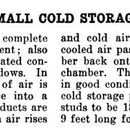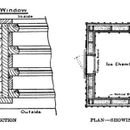1911 Stack Effect Air Circulation
This Cold Storage Haus is pretty cool.
Super Insulated, Thermal Bridge Free, Good Airtightness, Quad Glazing, No-Foam, No-Electricity
1911
Page 99
http://books.google.com/books?id=plY1AAAAMAAJ&pg=PA99&dq=William+a+radford+old+house+drawings#v=onepage&q&f=false
I think The Air Circulation Stratagem is really cool
GBA Detail Library
A collection of one thousand construction details organized by climate and house part













Replies
Well as it's based on the recently discredited 'natural law that warm air rises and cold air falls' we all know that this arrangement could never have worked. ;-)
James, I noticed the not-so-Sumner-Miller wording and I included the caption to be fair.
I am curious about the origin of the term "stack"
Is it just slang for chimney?...like a stack of bricks?
Then Stack =a process that behaves like a chimney?
或are chimneys called stacks beacause of some sort of "stacking" effect?
related to a column or stack of parcels of air?
John,
I agree with you,
This stratagem is very "cool" ;-)
The Google-Book version is not-so-high-resolution.
I am attaching a pdf scan from my hard copy of the Radford book
Hopefully it will be easier to see some of the subtle details and arrows
John,
Do you know what this is?
Is it a floor drain for melt-water do you think?
If it is a drain, it must just allow water to drain into the sand.
Otherwise some of that cold air would be making it's way out the drainpipe.
I'm thinking that in those days, you wouldn't want to let much of that cold air go to waste.
Lucas, I also figured it was collecting the Ice-Melt... and they do seem to be pretty serious about air-tightness....
I thought this detail was interesting... the baffle on the ceiling ..
ventilation gap? pressure moderation?
I noticed the interior wall boarding(cladding) also has a "gap"
Lucas, I'm sure you're correct that it's a melt-water drain but I'm fairly sure it would be allowed to drain freely to the side. If the sand became saturated the assembly would flood and the ice melt prematurely. The drain exit would be a point of negative pressure in the system so there'd be no loss of air from the loop at that point, only air entry if the top of the stack was not sufficiently sealed. A simple flap valve would help with that.
Stack effect obviously derives from chimney stack, but why is it called that? My first thought was the stone, bricks, or chinked logs that were stacked to achieve the vertical structure but we don't call it a wall stack when similarly constructed, and isn't just 'chimney' by itself enough? Then I recalled the elaborate flue systems of eighteenth and nineteenth century multi-story townhomes where fireplaces and their flues were indeed stacked vertically one upon the other so that one chimney structure might have a dozen different flue terminals. Perhaps 'chimney stack' was coined to refer to multiple flues in one chimney?
或maybe the ceiling baffle is also there to influence the air towards the warm air flue...and maybe it helps keep the bottom surface of the baffle cooler?
I noticed there is not a baffle on the Ice chamber side
maybe they wanted the "warm air to fall" as it sometimes does ;--)
just guessing out loud
John,
I found this document"A general routine for analysis for stack effect".
I've only just skimmed through it but it looks like it may contain some interesting information.
One thing that stood out on my initial skim:
James,
Good point.
Not to mention increased potential for rot in the untreated wood foundation...
I wonder how tight this structure would test with a blower door...
I'm not sure I see yet how the pressure boundary is established at all points...
Maybe since they lacked tapes and "goo", the pressure boundary is a result of "the sum of all parts".
Sort of like how RR used to describe his wall assemblies as a "cellulose sponge".
John,
Maybe you're right that they were thinknig about "pressure moderation" to help buffer out pressure variation from wind effects...
On second thought... maybe not...
I wonder if the pressure boundary in this "cold storage haus" can be defined by a "red line"...
或if it is "the sum of all parts"...
It is very likely not PH tight... but there are many sort-of tight layers... 3 layers of tongue & grove boarding and 2 layers of paper , battens ...and packed with sawdust .....so it probably does sum up to pretty darn tight
Lucas, I saw your red question mark.... I noticed that missing "boarding"
It must be an error...otherwise the sawdust would fall out
John,
What do you think of this little thought experiment:
You have a newly commissioned pretty darn tight "cold storage haus".
Because the "cold storage haus" is pretty darn tight, we ignore the effects of infiltration through the envelope, concentrating instead on what's happening in the interior environment.
Your first ice is delivered and put in the "ice chamber" and you stay inside, closing the door after the delivery guys.
Air circulation (in the manner described by the arrows in the CSH manual) is initially significant and the rate of ice melting is quite high as the interior environment moves out of equilibrium with the exterior environment.
As the air inside the "cold storage haus" is cooled, air circulation gradually slows and the rate of ice melting decreases until the interior environment reaches a new equilibrium between the cooling effects of the ice and the small amount of heat energy inevitably making it's way through the sawdust insulation from the exterior - in addition to other small heat gains like your body heat and the earth.
You're chilled because all the cold air has pooled at floor level while the ceiling in the "ice chamber" is high allowing the warmest air to rise far above.
突然,有人打开了门,前的ious cold air runs out in a laminar flow to where the exterior air is warmer and less dense. Meanwhile a flow of warmer air enters the door above the laminar flow of cold air - because your "cold storage haus" is pretty darn tight and nature abhors a vacuum.
You think to yourself that maybe your "cold storage haus" should have been built over a sunken floor...
Lucas, It sounds like you are promoting a basement.
You know I am an antibasementist.
I don't believe that when you open the icehaus door that the force will knock you down...or that all the cool air will suddenly spill out.....unless there is a hole at the top of the haus.
You know how you can't chug a beer very fast unless you punch a hole in the other end of the beer can?
and even if all of the air was rapidly "exchanged".....
I don't think there is much heat/coolth stored in the interior air as compared to the ice blocks, walls,ceiling and sand.
I remember when I built my house and first started my air conditioner(in August)...I was very,very surprised how long it took to cool the house down...I was starting to wonder if there was something wrong with my AC.....Once the structure and slab finally cooled...my house (the chamber) has been in "good condition" ever since.
very near the end of this video(5:45)
https://www.youtube.com/watch?v=Skran9E_Cjk
"there is a hole in that can ...and yet the water does not come out"
"and I say that's fantastic"
I think it is remarkable that the cooling room has not-so-small fixed windows on 2 sides....
how much daylight would they really need?
I wonder if they wanted the cooling room side to be warmer on purpose?...
to encourage "a current of air" to move
I wonder what the orientation of this building is?
and what climate is this for... is this near Illinois?....
what happens in the winter?.....does the glass have another purpose?
嗯,我不认为这将是一个好idea to leave the 2 leaf door open for very long...because eventually ...there woud be a full air exchange.
and I like your glug, glug description.
that's a good description of what I picture happening when the door is opened.
how deep are you suggesting to sink the floor?
perhaps the threshold of the door is already raised (we don't know)
John, I'm not sure I'm advocating a basement...
Maybe my description was over-dramatic.
And I agree that there will be much "coolth" stored in the assembly, the ice etc.
But I'm not-so-sure there wouldn't be some air exchange through the door...
You can't chug a beer very fast without punching a hole in the back of the can, but you can still get some beer.
I have a 5 gallon water jug with a spigot and a vent cap that I use for filling things.
If I forget to open the vent cap, water will still flow out - not nearly as quickly - but it will still flow in "glugs".
I think there are effects of scale to consider when comparing SM's "pin hole" demonstration with something the size of a house. For example, surface tension may be a significant factor in why water doesn't drip out.
A deep pool of cold air in the "ice haus" is a concentrated mass - it's heavy relative to the outside air.
Unless there is something to contain it (like the enclosure) or butress it (like equally dense air outside) then gravity will pull it down and spread it out.
Edit to say:
哦,
My "g" vector should point straight down.
I'm not really sure...
Maybe just a step or two...
I'm not even sure the idea's half-baked.
Maybe just for an old-school ice haus...